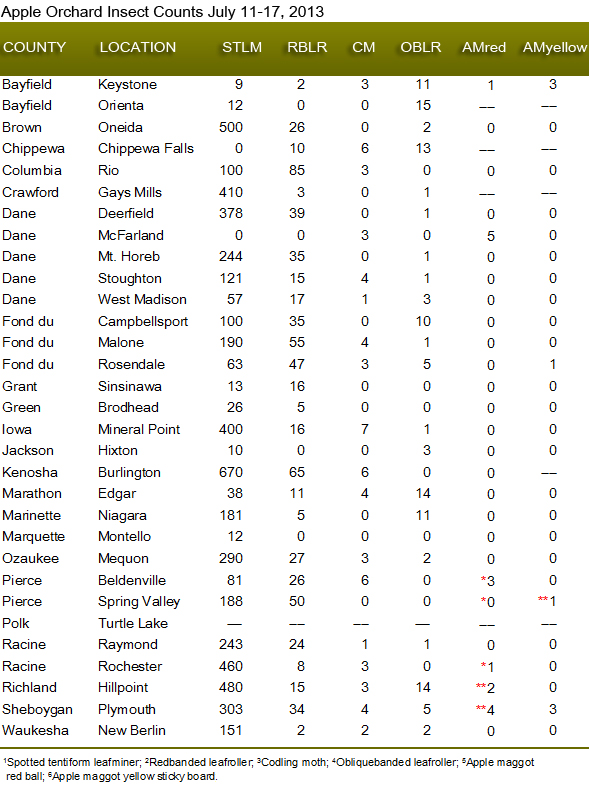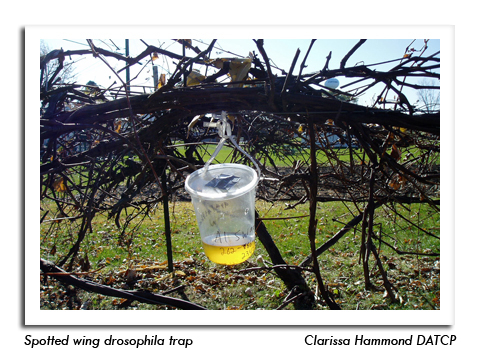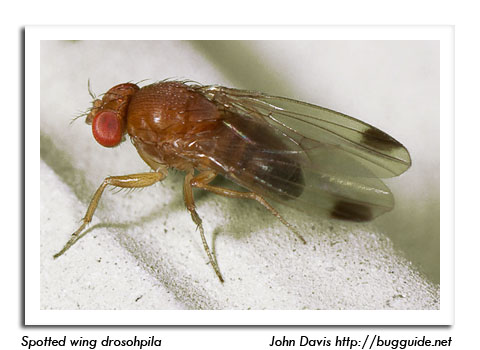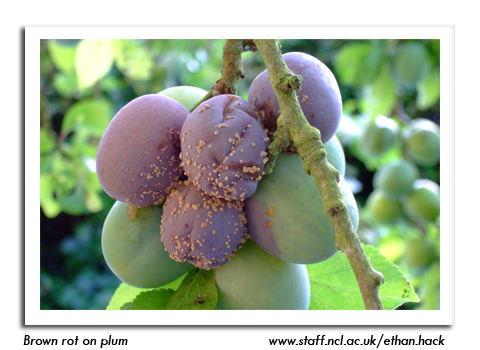
 |
|
|
Fruits
Volume 58 Number 11 Date 07/18/2013 SPOTTED WING DROSOPHILA - Two flies, one male and one female, were captured on June 24 in a yeast and sugar baited trap set by UW-Madison researchers on a Vernon County farm. This is the earliest recorded detection of SWD in the state since the first flies were discovered in 2010, although it should be noted that monitoring has never started this early in the growing season. In previous years, SWD traps were not set until late August or early September. A July 16 report issued by the UW Fruit Crops Entomologist Christelle Geudot also confirms the capture of additional flies in Crawford County. At this time, the threat of SWD to ripening fruit remains uncertain and it is not known if infestations will be as widespread or severe as in 2012. The first appearance of flies should serve as an early warning to fruit growers to escalate monitoring efforts (checking traps twice weekly), install barrier netting, or make preparations for possible insecticidal control. The use of insecticides is not advised until SWD infestation is verified by trapping or visual inspection. After the first flies or larvae are confirmed, applications of one of the insecticides registered for control of SWD may proceed at 4- to 5-day intervals from ripening through harvest. A list of insecticide options can be found on the UW-Madison SWD website at http://labs.russell.wisc.edu/swd/management-2/ . For organic operations, the OMFI-approved insecticides PyGanic and Entrust are available for SWD control. APPLE MAGGOT - The emergence of flies continued for the second week, with counts of 1-5 per trap at eight of 30 monitoring sites. Peak fly emergence remains a few weeks away. Apple growers are reminded that yellow traps baited with ammonium acetate are effective for approximately one week and should then be replaced or rebaited. Red sphere traps may be used with or without fruit essence lure through harvest. The economic threshold for apple maggot is one fly per unenhanced trap per week, or five flies per enhanced trap. CODLING MOTH - Counts have decreased in most orchards as populations transition into the larval stages. Orchardists who have not observed a distinct decline in moth activity and are having difficulty determining the most effective treatment window should use an accumulation of 1,000 degree days from the first spring biofix in late May to begin timing spray applications. As a general rule, there are about 1,000 degree days between the first and second larval generations. OBLIQUEBANDED LEAFROLLER - The first flight has subsided and second brood larvae are emerging. The small second brood larvae now feeding on terminals are controlled by most materials directed against second generation codling moths if CM treatments are made in the 7-10 days after the OBLR flight has ended. Scouting for OBLR terminal feeding is required to determine if codling moth sprays have effectively reduced OBLR levels or if additional measures are required to suppress populations and prevent fruit damage in August. SPOTTED TENTIFORM LEAFMINER - The peak of flight activity is approaching and egg laying is expected to be very heavy as long as the moths are numerous. Apple orchards with populations greater than one mine per leaf or a history of infestation are candidates for control of second generation larvae. SOOTY BLOTCH AND FLYSPECK - As mentioned last week, leaf wetness hours are adequate for fungicide sprays to be applied for sooty blotch and flyspeck control. The first cases of flyspeck appeared in orchards by July 4, while sooty blotch has not yet been reported or observed. Treatment for these summer diseases is most effective at 175 leaf wetness hours beyond petal fall. BROWN ROT - Orchard IPM Specialist, John Aue advises growers of cherries, peaches and plums to intensify scouting efforts for this destructive disease. Stone fruits are more susceptible to brown rot during ripening and serious outbreaks may occur during periods of humid or wet weather when sporulation and infection by the brown rot fungus is favored. A persistent fungicide spray schedule may be needed to prevent disease development. -- Krista Hamilton, DATCP Entomologist 





|
|
|